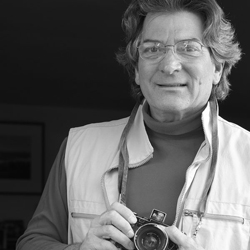Currently on view is an exceptional exhibition entitled "Engaged Observers," at the J. Paul Getty Museum. The Engaged Observers exhibition is about photojournalism and the electrifying power photography has to tell us about ourselves in intimate, disturbing, and provocative ways.Brilliantly conceived by Brett Abbott, Associate Curator of Photographs at the Getty, the exhibit focuses on nine diverse photographers and the particular social issues they felt strongly about. These photographers explored those issues in depth and with extraordinary vision. The exhibit spans the era from the 1960's through contemporary events, with some photos shot as recently as a few years ago.
 In addition, there is a related exhibit on the history of photojournalism that is very stimulating. Some of the most infamous and historically significant photographs ever taken are on display. They include "Death in the Making" by Robert Capa, 1938, a photograph of a Spanish Civil War resistance fighter in the grip of death at the moment he is struck by a bullet, and Walker Evans' compassionate photo of a family struggling to survive in the rural south during the Great Depression.
In addition, there is a related exhibit on the history of photojournalism that is very stimulating. Some of the most infamous and historically significant photographs ever taken are on display. They include "Death in the Making" by Robert Capa, 1938, a photograph of a Spanish Civil War resistance fighter in the grip of death at the moment he is struck by a bullet, and Walker Evans' compassionate photo of a family struggling to survive in the rural south during the Great Depression.
 In the broad sphere of art history, compared to other fine arts, photography is a tiny mark on the time-line of civilization, coming at the tail end of a long human journey that reflects and parallels the evolution of consciousness. From cave drawings, to Greek sculpture, to French Impressionism, to Pop Art, to Perceptual Abstraction and today's contemporary art, artists have interpreted everything including religion, sexuality, dreams, death, politics, famine . . . the list goes on.
However, during photography's brief history, humankind has come most sharply into focus. A crystal ball of reality is wrapped in latent image, accomplished through light-sensitive emulsions or digital information and joined with fine optics (lenses and camera bodies), photography has given us a personal and generous clarity about who we are, what we look like and what our planet earth looks like; both in great detail and from as great a distance as Outer Space. It demonstrates, in deeply vivid and emotional ways, how we treat one another.
In the broad sphere of art history, compared to other fine arts, photography is a tiny mark on the time-line of civilization, coming at the tail end of a long human journey that reflects and parallels the evolution of consciousness. From cave drawings, to Greek sculpture, to French Impressionism, to Pop Art, to Perceptual Abstraction and today's contemporary art, artists have interpreted everything including religion, sexuality, dreams, death, politics, famine . . . the list goes on.
However, during photography's brief history, humankind has come most sharply into focus. A crystal ball of reality is wrapped in latent image, accomplished through light-sensitive emulsions or digital information and joined with fine optics (lenses and camera bodies), photography has given us a personal and generous clarity about who we are, what we look like and what our planet earth looks like; both in great detail and from as great a distance as Outer Space. It demonstrates, in deeply vivid and emotional ways, how we treat one another.
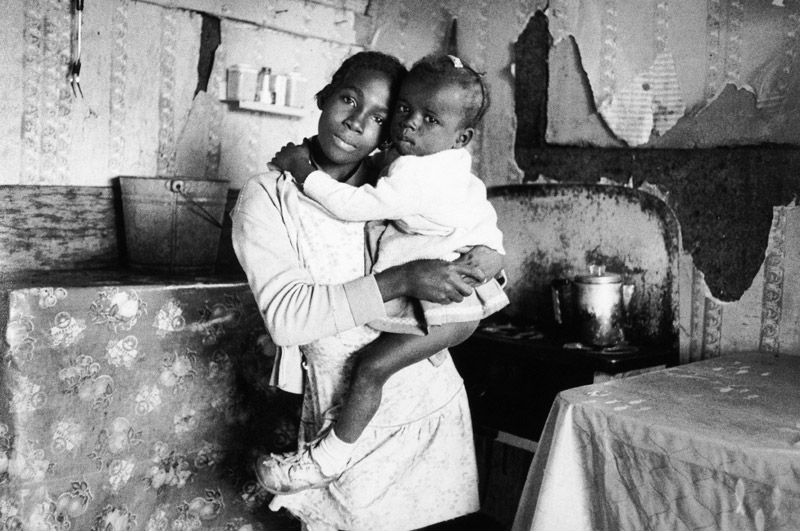 Photography allows us to reflect on our world individually, culturally, scientifically, and ultimately, existentially. Many of these qualities are unique to the art and majesty of photography. They were not fathomable even a few hundred years ago, or even possible, for that matter, because photography simply did not exist.
All the photographers whose work appears in "Engaged Observers Exhibition" share a true passion for the extended photo essay. Many of them spent years, sometimes many years, developing stories that were later published as books.
In classic Magnum photo-journalistic style Leonard Freed's photographs from his series "Black In White America" are touching in their humanity; both in the spirit and in the events he recorded. They are an important series that demonstrate a personal and genuine effort on Freed's part to bear witness to everyday occurrences that black families experienced during the civil rights movement of the 1960's. Southern racism was harsh with segregation of whites and blacks, in business, worship, schools, and society. Freed's photography addressed racism head on. He tenderly photographed precious black children growing up in New York. His photographs of a jazz funeral in New Orleans validate our sense of wonder and illuminate our understanding of that great musical tradition and the musicians themselves.
Photography allows us to reflect on our world individually, culturally, scientifically, and ultimately, existentially. Many of these qualities are unique to the art and majesty of photography. They were not fathomable even a few hundred years ago, or even possible, for that matter, because photography simply did not exist.
All the photographers whose work appears in "Engaged Observers Exhibition" share a true passion for the extended photo essay. Many of them spent years, sometimes many years, developing stories that were later published as books.
In classic Magnum photo-journalistic style Leonard Freed's photographs from his series "Black In White America" are touching in their humanity; both in the spirit and in the events he recorded. They are an important series that demonstrate a personal and genuine effort on Freed's part to bear witness to everyday occurrences that black families experienced during the civil rights movement of the 1960's. Southern racism was harsh with segregation of whites and blacks, in business, worship, schools, and society. Freed's photography addressed racism head on. He tenderly photographed precious black children growing up in New York. His photographs of a jazz funeral in New Orleans validate our sense of wonder and illuminate our understanding of that great musical tradition and the musicians themselves.
 Sebastiao Salgado is one of the most famous photojournalists alive today. He continues to produce extraordinary photo essays on vital human issues. He has traveled to over 100 countries for his photographic projects. He has compassionately documented worker's rights all over the world, many in terribly underdeveloped countries; he has photographed refugees in Ethiopia; he has explored and recorded parts of the planet still virginal, innocent and unaffected by the touch of modernization.
Sebastiao Salgado is one of the most famous photojournalists alive today. He continues to produce extraordinary photo essays on vital human issues. He has traveled to over 100 countries for his photographic projects. He has compassionately documented worker's rights all over the world, many in terribly underdeveloped countries; he has photographed refugees in Ethiopia; he has explored and recorded parts of the planet still virginal, innocent and unaffected by the touch of modernization.
 The Getty exhibit includes his "Migrations - Humanity in Transition" series. This epic work of twentieth century photojournalism documents people across forty-three countries uprooted by globalization, persecution, or war. Salgado's portraits transform individuals into universal symbols of endurance in the face of incredibly complex global problems. He has an elegant eye; and many of his photographs are outright stunning to look at.
Mary Ellen Mark is among the most recognized photojournalists of our day. She is celebrated for her epic photo essays on the social environment, both domestically and internationally. Of particular concern to her are people living on the edge, on the boarder of mainstream culture. Mark learned that by staying with her subjects for extended periods of time, her relentless and dedicated coverage helped to secure both trust and thoughtful documentation. A classic example is her photo essay, in color, of prostitutes in Bombay (now Mumbai).
The Getty exhibit includes his "Migrations - Humanity in Transition" series. This epic work of twentieth century photojournalism documents people across forty-three countries uprooted by globalization, persecution, or war. Salgado's portraits transform individuals into universal symbols of endurance in the face of incredibly complex global problems. He has an elegant eye; and many of his photographs are outright stunning to look at.
Mary Ellen Mark is among the most recognized photojournalists of our day. She is celebrated for her epic photo essays on the social environment, both domestically and internationally. Of particular concern to her are people living on the edge, on the boarder of mainstream culture. Mark learned that by staying with her subjects for extended periods of time, her relentless and dedicated coverage helped to secure both trust and thoughtful documentation. A classic example is her photo essay, in color, of prostitutes in Bombay (now Mumbai).  Very different in appearance and subject, "Streetwise," the photographs in this exhibit, are shot in black & white. Mark's essay "Streets Of The Lost" started as a Life magazine story, a photo essay on runaway children in America. Mark, along with a reporter, chose Seattle for this story.
Very different in appearance and subject, "Streetwise," the photographs in this exhibit, are shot in black & white. Mark's essay "Streets Of The Lost" started as a Life magazine story, a photo essay on runaway children in America. Mark, along with a reporter, chose Seattle for this story.  At that time, more than one million children between the ages of eleven and seventeen ran away from home each year. Mark created an intimate portrait of teenagers, who survive on the tough streets through petty crime, prostitution, dumpster diving, and panhandling.
A photograph of two boys, one of them holding an automatic revolver hidden in his jacket, has an emotionally chilling effect.
At that time, more than one million children between the ages of eleven and seventeen ran away from home each year. Mark created an intimate portrait of teenagers, who survive on the tough streets through petty crime, prostitution, dumpster diving, and panhandling.
A photograph of two boys, one of them holding an automatic revolver hidden in his jacket, has an emotionally chilling effect.
 W Eugene Smith is another one of the greatest photographers of the Twentieth Century. His dedication to photojournalism as a leading producer of magazine-based photo essays is remarkable. He is credited with pushing the narrative and expressive potential of photojournalism to new levels of intensity.
W Eugene Smith is another one of the greatest photographers of the Twentieth Century. His dedication to photojournalism as a leading producer of magazine-based photo essays is remarkable. He is credited with pushing the narrative and expressive potential of photojournalism to new levels of intensity.  He was obsessed with making beautiful prints from his negatives, on a par with Ansel Adams. Having become a legend in his own time for his socially conscious photography, (he died at age 60 in 1978), one of his greatest accomplishments was a photo essay on "Minamata" included in the exhibition. Minamata is a small Japanese fishing village where industrial pollution caused hideous birth defects and debilitating symptoms and death, among local families. The illness was caused
He was obsessed with making beautiful prints from his negatives, on a par with Ansel Adams. Having become a legend in his own time for his socially conscious photography, (he died at age 60 in 1978), one of his greatest accomplishments was a photo essay on "Minamata" included in the exhibition. Minamata is a small Japanese fishing village where industrial pollution caused hideous birth defects and debilitating symptoms and death, among local families. The illness was caused 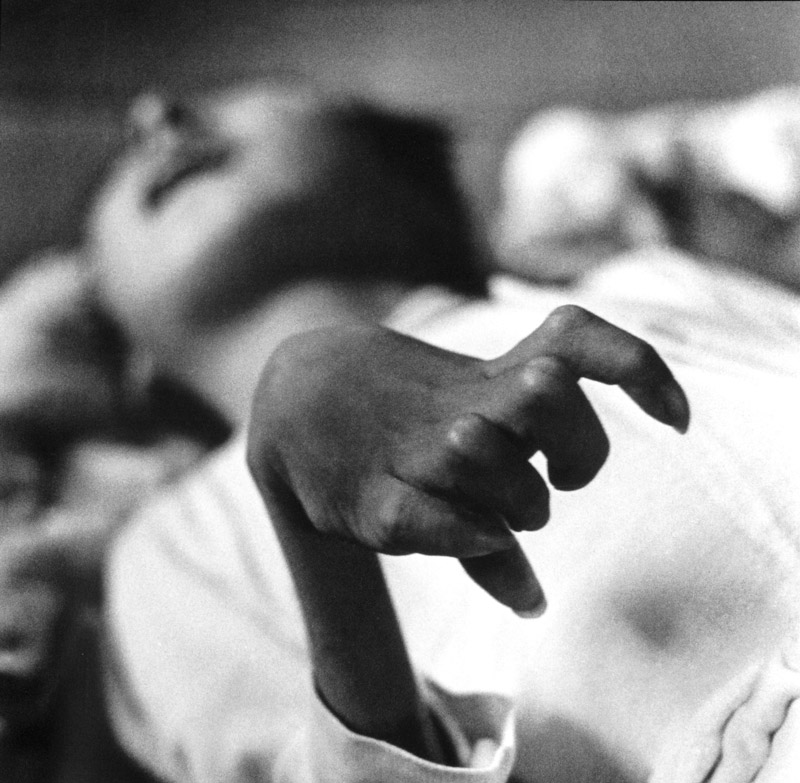 by severe mercury poisoning through eating fish that was contaminated by wastewater from a local factory. Smith's photographs on this tragic village inspired the modern environmental movement and remain one of the greatest statements ever made against corporate pollution.
The factory continued to pollute the water until1968 and finally settled the last case in March of this year (2010). All of this was masterly demonstrated in Smith's photographs.
Three of the photographers in the exhibit deal with "WAR" and its consequences in three very different and penetrating ways.
by severe mercury poisoning through eating fish that was contaminated by wastewater from a local factory. Smith's photographs on this tragic village inspired the modern environmental movement and remain one of the greatest statements ever made against corporate pollution.
The factory continued to pollute the water until1968 and finally settled the last case in March of this year (2010). All of this was masterly demonstrated in Smith's photographs.
Three of the photographers in the exhibit deal with "WAR" and its consequences in three very different and penetrating ways.
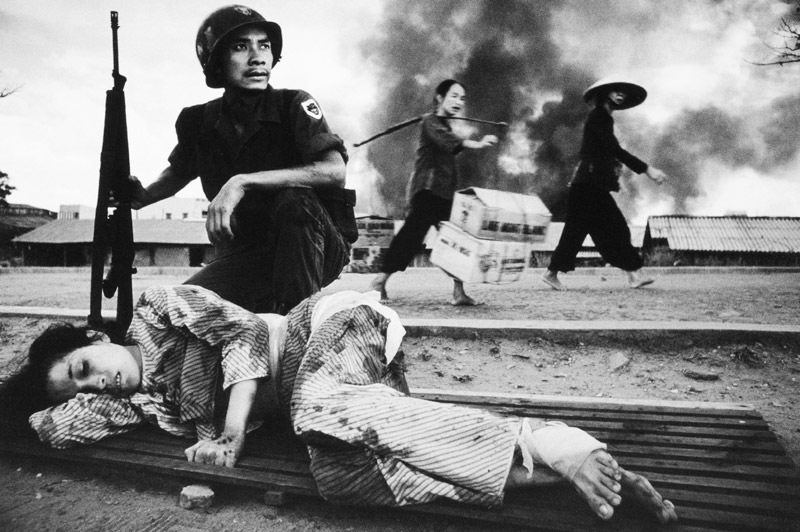 All of them tell us what already know; that warfare is dark, horribly dark. A life is truly special; no matter what country a person is from or what ideology they kill and die for. Some are freedom fighters, and some are professional soldiers.
Phillip Jones Griffiths' photographs of the Vietnam war are some of the finest examples of warfare photography since the Civil War era. What makes his photographs important is that he illustrates how the Vietnam war directly affected native people. He gives us a compassionate perspective, from their standpoint. Griffiths is a very fine photographer with a soulful eye.
All of them tell us what already know; that warfare is dark, horribly dark. A life is truly special; no matter what country a person is from or what ideology they kill and die for. Some are freedom fighters, and some are professional soldiers.
Phillip Jones Griffiths' photographs of the Vietnam war are some of the finest examples of warfare photography since the Civil War era. What makes his photographs important is that he illustrates how the Vietnam war directly affected native people. He gives us a compassionate perspective, from their standpoint. Griffiths is a very fine photographer with a soulful eye.
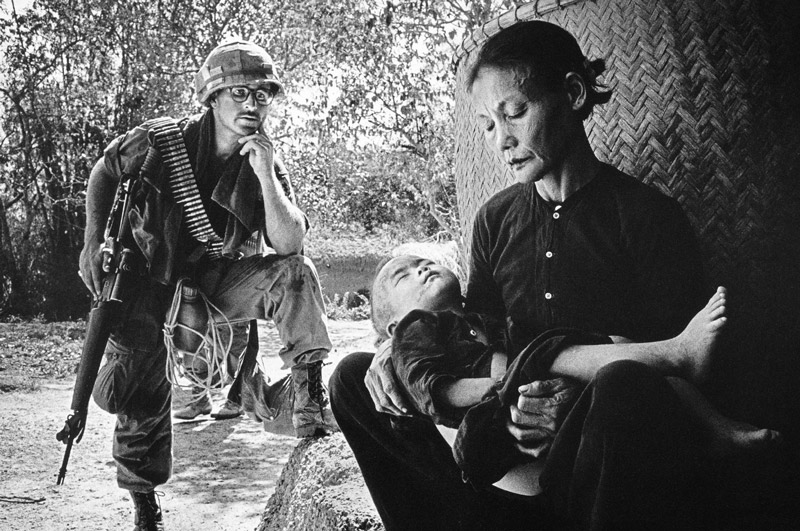 In 1978 Susan Meiselas first traveled to Nicaragua. Soon thereafter she became deeply involved photographing the country's struggle to overthrow
In 1978 Susan Meiselas first traveled to Nicaragua. Soon thereafter she became deeply involved photographing the country's struggle to overthrow  the then-Somoza government, aggressively repressive and backed by the United States' military aid.
Her brilliant photographs, shot in vivid color, create a visual drama; her compositions are highly artistic and beautiful.
She documents well the bravery of those willing to risk their lives against the dictatorship for the promise of a better future.
the then-Somoza government, aggressively repressive and backed by the United States' military aid.
Her brilliant photographs, shot in vivid color, create a visual drama; her compositions are highly artistic and beautiful.
She documents well the bravery of those willing to risk their lives against the dictatorship for the promise of a better future.
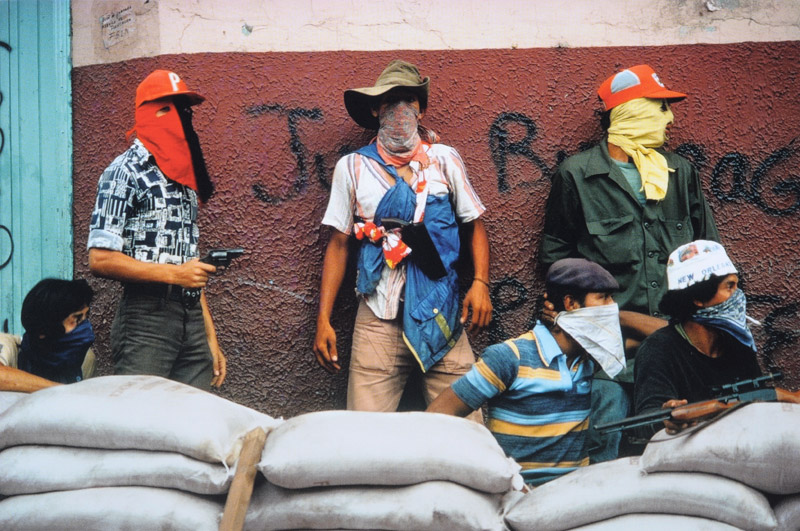 James Nachtwey has a piece in the exhibit with the sophistication and power of Picasso's "Guernica" (a force-full antiwar painting about a destroyed town in Spain). It is a long (over 30-foot) panel of individual photographs butted up against one another. The seamed photographs are the most intense imaginable.
James Nachtwey has a piece in the exhibit with the sophistication and power of Picasso's "Guernica" (a force-full antiwar painting about a destroyed town in Spain). It is a long (over 30-foot) panel of individual photographs butted up against one another. The seamed photographs are the most intense imaginable.
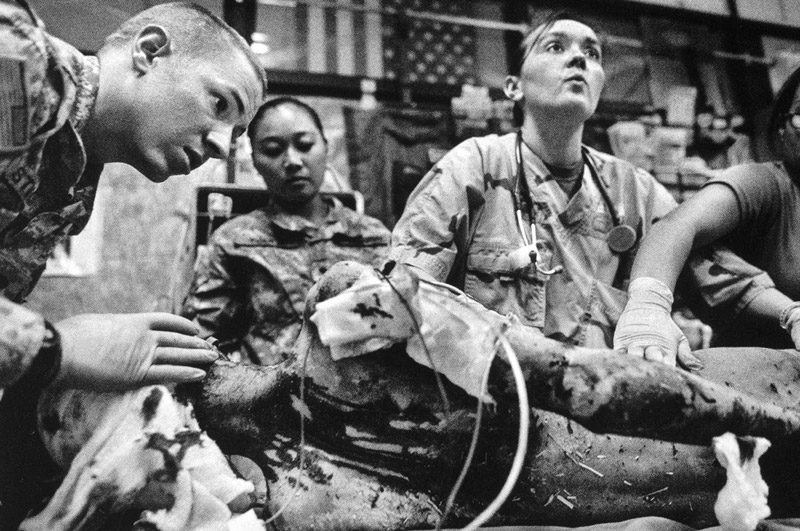 They are photos of American soldiers being treated in an emergency triage tent after being wounded in action. Their lives are in the balance, entrusted to the field medical teams.
The pictures are visceral and explicit. The images are black and white, which abstract the disturbing account of what is taking place. Nachtwey considers himself an antiwar photographer, which is different from a war photographer. Assembled together, this panel is entitled "The Sacrifice 2007" about U.S. troops currently stationed in the Mideast. They are reminiscent of Goya's "Disasters of War."
They are photos of American soldiers being treated in an emergency triage tent after being wounded in action. Their lives are in the balance, entrusted to the field medical teams.
The pictures are visceral and explicit. The images are black and white, which abstract the disturbing account of what is taking place. Nachtwey considers himself an antiwar photographer, which is different from a war photographer. Assembled together, this panel is entitled "The Sacrifice 2007" about U.S. troops currently stationed in the Mideast. They are reminiscent of Goya's "Disasters of War."
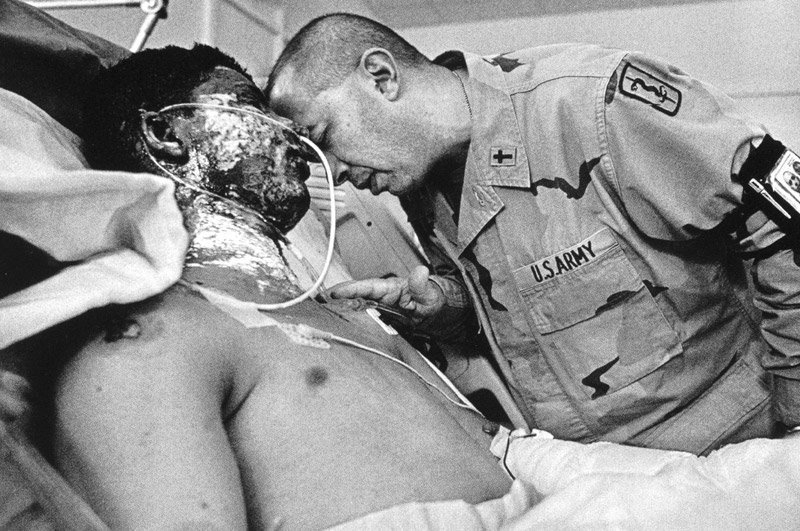 Larry Towell's photographs of "the Mennonites," a strict religious group from Europe in the 1500's, are tender and compassionate. They function as a sympathetic portrait of these highly spiritual people and are a wonderful alternative to the harsh photographs of war. He spent over ten years on the project photographing the Mennonites way of life with his unique and intimate access, and capturing their joys and challenges.
Larry Towell's photographs of "the Mennonites," a strict religious group from Europe in the 1500's, are tender and compassionate. They function as a sympathetic portrait of these highly spiritual people and are a wonderful alternative to the harsh photographs of war. He spent over ten years on the project photographing the Mennonites way of life with his unique and intimate access, and capturing their joys and challenges.
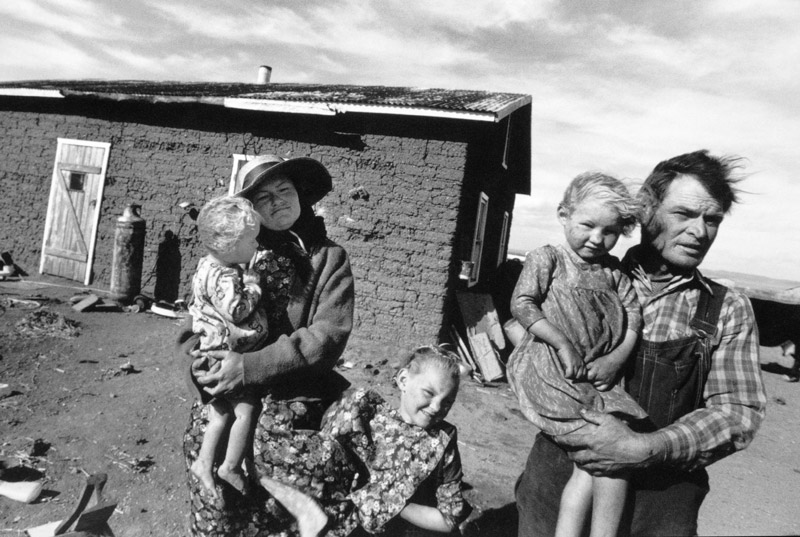 Of all the photographic essays appearing in "Engaged Observers Exhibition" the most current is by photographer Lauren Greenfield. Titled "Fast Forward And Girl Culture," it has a contemporary look with large color prints.
Of all the photographic essays appearing in "Engaged Observers Exhibition" the most current is by photographer Lauren Greenfield. Titled "Fast Forward And Girl Culture," it has a contemporary look with large color prints. 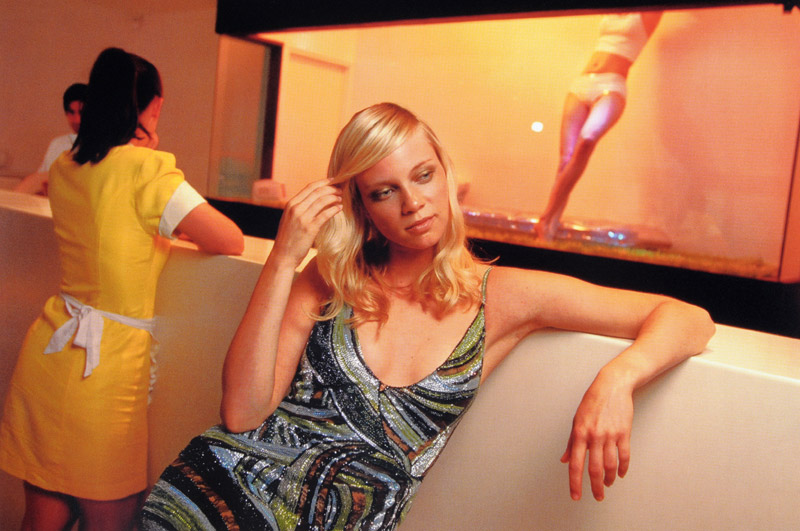 The selection peeks into the future of photojournalism with a digital pixel feel. It makes an interesting comparison to the older photo essays exhibited in the show, which were mostly shot in black and white with the grain of the film clearly visible in the exhibition prints.
The selection peeks into the future of photojournalism with a digital pixel feel. It makes an interesting comparison to the older photo essays exhibited in the show, which were mostly shot in black and white with the grain of the film clearly visible in the exhibition prints. 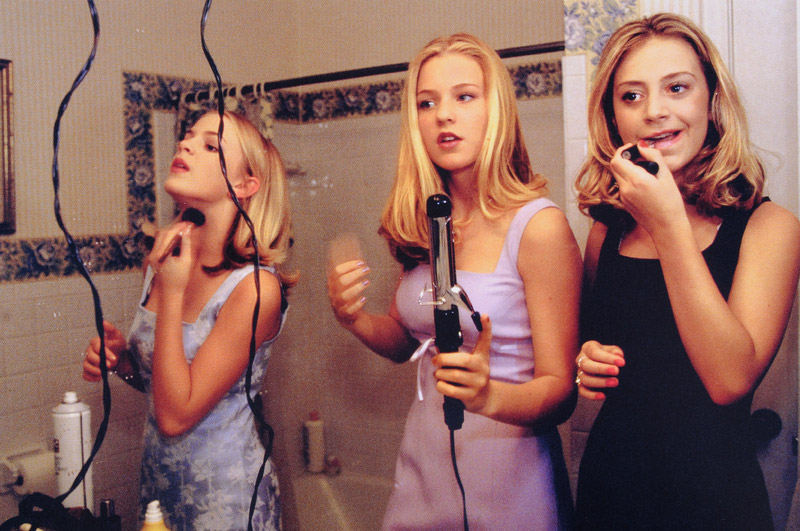 Greenfield, a native of Los Angeles, grew up surrounded by Hollywood sensibilities. With the eye of a tiger, she knew just where to go and what to shoot to record a "girl culture," obsessed with being thin, eternally young and sexy. Her photographs inspire an interesting discussion about vanity and how quickly the young lose their innocence.
"Engaged Observers Exhibition" is definitely a worthy view in-person. Rarely will you see, so many fine examples of photojournalism in one place, pushing the boundaries of "art." The process of photojournalism is to encompass larger aims and inspire contemplation. This exhibit clearly does that extensively, and much, much more. The exhibition runs through November 14, 2010 at the Getty Center in Brentwood, Los Angeles.
Greenfield, a native of Los Angeles, grew up surrounded by Hollywood sensibilities. With the eye of a tiger, she knew just where to go and what to shoot to record a "girl culture," obsessed with being thin, eternally young and sexy. Her photographs inspire an interesting discussion about vanity and how quickly the young lose their innocence.
"Engaged Observers Exhibition" is definitely a worthy view in-person. Rarely will you see, so many fine examples of photojournalism in one place, pushing the boundaries of "art." The process of photojournalism is to encompass larger aims and inspire contemplation. This exhibit clearly does that extensively, and much, much more. The exhibition runs through November 14, 2010 at the Getty Center in Brentwood, Los Angeles.
 In addition, there is a related exhibit on the history of photojournalism that is very stimulating. Some of the most infamous and historically significant photographs ever taken are on display. They include "Death in the Making" by Robert Capa, 1938, a photograph of a Spanish Civil War resistance fighter in the grip of death at the moment he is struck by a bullet, and Walker Evans' compassionate photo of a family struggling to survive in the rural south during the Great Depression.
In addition, there is a related exhibit on the history of photojournalism that is very stimulating. Some of the most infamous and historically significant photographs ever taken are on display. They include "Death in the Making" by Robert Capa, 1938, a photograph of a Spanish Civil War resistance fighter in the grip of death at the moment he is struck by a bullet, and Walker Evans' compassionate photo of a family struggling to survive in the rural south during the Great Depression.
 In the broad sphere of art history, compared to other fine arts, photography is a tiny mark on the time-line of civilization, coming at the tail end of a long human journey that reflects and parallels the evolution of consciousness. From cave drawings, to Greek sculpture, to French Impressionism, to Pop Art, to Perceptual Abstraction and today's contemporary art, artists have interpreted everything including religion, sexuality, dreams, death, politics, famine . . . the list goes on.
However, during photography's brief history, humankind has come most sharply into focus. A crystal ball of reality is wrapped in latent image, accomplished through light-sensitive emulsions or digital information and joined with fine optics (lenses and camera bodies), photography has given us a personal and generous clarity about who we are, what we look like and what our planet earth looks like; both in great detail and from as great a distance as Outer Space. It demonstrates, in deeply vivid and emotional ways, how we treat one another.
In the broad sphere of art history, compared to other fine arts, photography is a tiny mark on the time-line of civilization, coming at the tail end of a long human journey that reflects and parallels the evolution of consciousness. From cave drawings, to Greek sculpture, to French Impressionism, to Pop Art, to Perceptual Abstraction and today's contemporary art, artists have interpreted everything including religion, sexuality, dreams, death, politics, famine . . . the list goes on.
However, during photography's brief history, humankind has come most sharply into focus. A crystal ball of reality is wrapped in latent image, accomplished through light-sensitive emulsions or digital information and joined with fine optics (lenses and camera bodies), photography has given us a personal and generous clarity about who we are, what we look like and what our planet earth looks like; both in great detail and from as great a distance as Outer Space. It demonstrates, in deeply vivid and emotional ways, how we treat one another.
 Photography allows us to reflect on our world individually, culturally, scientifically, and ultimately, existentially. Many of these qualities are unique to the art and majesty of photography. They were not fathomable even a few hundred years ago, or even possible, for that matter, because photography simply did not exist.
All the photographers whose work appears in "Engaged Observers Exhibition" share a true passion for the extended photo essay. Many of them spent years, sometimes many years, developing stories that were later published as books.
In classic Magnum photo-journalistic style Leonard Freed's photographs from his series "Black In White America" are touching in their humanity; both in the spirit and in the events he recorded. They are an important series that demonstrate a personal and genuine effort on Freed's part to bear witness to everyday occurrences that black families experienced during the civil rights movement of the 1960's. Southern racism was harsh with segregation of whites and blacks, in business, worship, schools, and society. Freed's photography addressed racism head on. He tenderly photographed precious black children growing up in New York. His photographs of a jazz funeral in New Orleans validate our sense of wonder and illuminate our understanding of that great musical tradition and the musicians themselves.
Photography allows us to reflect on our world individually, culturally, scientifically, and ultimately, existentially. Many of these qualities are unique to the art and majesty of photography. They were not fathomable even a few hundred years ago, or even possible, for that matter, because photography simply did not exist.
All the photographers whose work appears in "Engaged Observers Exhibition" share a true passion for the extended photo essay. Many of them spent years, sometimes many years, developing stories that were later published as books.
In classic Magnum photo-journalistic style Leonard Freed's photographs from his series "Black In White America" are touching in their humanity; both in the spirit and in the events he recorded. They are an important series that demonstrate a personal and genuine effort on Freed's part to bear witness to everyday occurrences that black families experienced during the civil rights movement of the 1960's. Southern racism was harsh with segregation of whites and blacks, in business, worship, schools, and society. Freed's photography addressed racism head on. He tenderly photographed precious black children growing up in New York. His photographs of a jazz funeral in New Orleans validate our sense of wonder and illuminate our understanding of that great musical tradition and the musicians themselves.
 Sebastiao Salgado is one of the most famous photojournalists alive today. He continues to produce extraordinary photo essays on vital human issues. He has traveled to over 100 countries for his photographic projects. He has compassionately documented worker's rights all over the world, many in terribly underdeveloped countries; he has photographed refugees in Ethiopia; he has explored and recorded parts of the planet still virginal, innocent and unaffected by the touch of modernization.
Sebastiao Salgado is one of the most famous photojournalists alive today. He continues to produce extraordinary photo essays on vital human issues. He has traveled to over 100 countries for his photographic projects. He has compassionately documented worker's rights all over the world, many in terribly underdeveloped countries; he has photographed refugees in Ethiopia; he has explored and recorded parts of the planet still virginal, innocent and unaffected by the touch of modernization.
 The Getty exhibit includes his "Migrations - Humanity in Transition" series. This epic work of twentieth century photojournalism documents people across forty-three countries uprooted by globalization, persecution, or war. Salgado's portraits transform individuals into universal symbols of endurance in the face of incredibly complex global problems. He has an elegant eye; and many of his photographs are outright stunning to look at.
Mary Ellen Mark is among the most recognized photojournalists of our day. She is celebrated for her epic photo essays on the social environment, both domestically and internationally. Of particular concern to her are people living on the edge, on the boarder of mainstream culture. Mark learned that by staying with her subjects for extended periods of time, her relentless and dedicated coverage helped to secure both trust and thoughtful documentation. A classic example is her photo essay, in color, of prostitutes in Bombay (now Mumbai).
The Getty exhibit includes his "Migrations - Humanity in Transition" series. This epic work of twentieth century photojournalism documents people across forty-three countries uprooted by globalization, persecution, or war. Salgado's portraits transform individuals into universal symbols of endurance in the face of incredibly complex global problems. He has an elegant eye; and many of his photographs are outright stunning to look at.
Mary Ellen Mark is among the most recognized photojournalists of our day. She is celebrated for her epic photo essays on the social environment, both domestically and internationally. Of particular concern to her are people living on the edge, on the boarder of mainstream culture. Mark learned that by staying with her subjects for extended periods of time, her relentless and dedicated coverage helped to secure both trust and thoughtful documentation. A classic example is her photo essay, in color, of prostitutes in Bombay (now Mumbai).  Very different in appearance and subject, "Streetwise," the photographs in this exhibit, are shot in black & white. Mark's essay "Streets Of The Lost" started as a Life magazine story, a photo essay on runaway children in America. Mark, along with a reporter, chose Seattle for this story.
Very different in appearance and subject, "Streetwise," the photographs in this exhibit, are shot in black & white. Mark's essay "Streets Of The Lost" started as a Life magazine story, a photo essay on runaway children in America. Mark, along with a reporter, chose Seattle for this story.  At that time, more than one million children between the ages of eleven and seventeen ran away from home each year. Mark created an intimate portrait of teenagers, who survive on the tough streets through petty crime, prostitution, dumpster diving, and panhandling.
A photograph of two boys, one of them holding an automatic revolver hidden in his jacket, has an emotionally chilling effect.
At that time, more than one million children between the ages of eleven and seventeen ran away from home each year. Mark created an intimate portrait of teenagers, who survive on the tough streets through petty crime, prostitution, dumpster diving, and panhandling.
A photograph of two boys, one of them holding an automatic revolver hidden in his jacket, has an emotionally chilling effect.
 W Eugene Smith is another one of the greatest photographers of the Twentieth Century. His dedication to photojournalism as a leading producer of magazine-based photo essays is remarkable. He is credited with pushing the narrative and expressive potential of photojournalism to new levels of intensity.
W Eugene Smith is another one of the greatest photographers of the Twentieth Century. His dedication to photojournalism as a leading producer of magazine-based photo essays is remarkable. He is credited with pushing the narrative and expressive potential of photojournalism to new levels of intensity.  He was obsessed with making beautiful prints from his negatives, on a par with Ansel Adams. Having become a legend in his own time for his socially conscious photography, (he died at age 60 in 1978), one of his greatest accomplishments was a photo essay on "Minamata" included in the exhibition. Minamata is a small Japanese fishing village where industrial pollution caused hideous birth defects and debilitating symptoms and death, among local families. The illness was caused
He was obsessed with making beautiful prints from his negatives, on a par with Ansel Adams. Having become a legend in his own time for his socially conscious photography, (he died at age 60 in 1978), one of his greatest accomplishments was a photo essay on "Minamata" included in the exhibition. Minamata is a small Japanese fishing village where industrial pollution caused hideous birth defects and debilitating symptoms and death, among local families. The illness was caused  by severe mercury poisoning through eating fish that was contaminated by wastewater from a local factory. Smith's photographs on this tragic village inspired the modern environmental movement and remain one of the greatest statements ever made against corporate pollution.
The factory continued to pollute the water until1968 and finally settled the last case in March of this year (2010). All of this was masterly demonstrated in Smith's photographs.
Three of the photographers in the exhibit deal with "WAR" and its consequences in three very different and penetrating ways.
by severe mercury poisoning through eating fish that was contaminated by wastewater from a local factory. Smith's photographs on this tragic village inspired the modern environmental movement and remain one of the greatest statements ever made against corporate pollution.
The factory continued to pollute the water until1968 and finally settled the last case in March of this year (2010). All of this was masterly demonstrated in Smith's photographs.
Three of the photographers in the exhibit deal with "WAR" and its consequences in three very different and penetrating ways.
 All of them tell us what already know; that warfare is dark, horribly dark. A life is truly special; no matter what country a person is from or what ideology they kill and die for. Some are freedom fighters, and some are professional soldiers.
Phillip Jones Griffiths' photographs of the Vietnam war are some of the finest examples of warfare photography since the Civil War era. What makes his photographs important is that he illustrates how the Vietnam war directly affected native people. He gives us a compassionate perspective, from their standpoint. Griffiths is a very fine photographer with a soulful eye.
All of them tell us what already know; that warfare is dark, horribly dark. A life is truly special; no matter what country a person is from or what ideology they kill and die for. Some are freedom fighters, and some are professional soldiers.
Phillip Jones Griffiths' photographs of the Vietnam war are some of the finest examples of warfare photography since the Civil War era. What makes his photographs important is that he illustrates how the Vietnam war directly affected native people. He gives us a compassionate perspective, from their standpoint. Griffiths is a very fine photographer with a soulful eye.
 In 1978 Susan Meiselas first traveled to Nicaragua. Soon thereafter she became deeply involved photographing the country's struggle to overthrow
In 1978 Susan Meiselas first traveled to Nicaragua. Soon thereafter she became deeply involved photographing the country's struggle to overthrow  the then-Somoza government, aggressively repressive and backed by the United States' military aid.
Her brilliant photographs, shot in vivid color, create a visual drama; her compositions are highly artistic and beautiful.
She documents well the bravery of those willing to risk their lives against the dictatorship for the promise of a better future.
the then-Somoza government, aggressively repressive and backed by the United States' military aid.
Her brilliant photographs, shot in vivid color, create a visual drama; her compositions are highly artistic and beautiful.
She documents well the bravery of those willing to risk their lives against the dictatorship for the promise of a better future.
 James Nachtwey has a piece in the exhibit with the sophistication and power of Picasso's "Guernica" (a force-full antiwar painting about a destroyed town in Spain). It is a long (over 30-foot) panel of individual photographs butted up against one another. The seamed photographs are the most intense imaginable.
James Nachtwey has a piece in the exhibit with the sophistication and power of Picasso's "Guernica" (a force-full antiwar painting about a destroyed town in Spain). It is a long (over 30-foot) panel of individual photographs butted up against one another. The seamed photographs are the most intense imaginable.
 They are photos of American soldiers being treated in an emergency triage tent after being wounded in action. Their lives are in the balance, entrusted to the field medical teams.
The pictures are visceral and explicit. The images are black and white, which abstract the disturbing account of what is taking place. Nachtwey considers himself an antiwar photographer, which is different from a war photographer. Assembled together, this panel is entitled "The Sacrifice 2007" about U.S. troops currently stationed in the Mideast. They are reminiscent of Goya's "Disasters of War."
They are photos of American soldiers being treated in an emergency triage tent after being wounded in action. Their lives are in the balance, entrusted to the field medical teams.
The pictures are visceral and explicit. The images are black and white, which abstract the disturbing account of what is taking place. Nachtwey considers himself an antiwar photographer, which is different from a war photographer. Assembled together, this panel is entitled "The Sacrifice 2007" about U.S. troops currently stationed in the Mideast. They are reminiscent of Goya's "Disasters of War."
 Larry Towell's photographs of "the Mennonites," a strict religious group from Europe in the 1500's, are tender and compassionate. They function as a sympathetic portrait of these highly spiritual people and are a wonderful alternative to the harsh photographs of war. He spent over ten years on the project photographing the Mennonites way of life with his unique and intimate access, and capturing their joys and challenges.
Larry Towell's photographs of "the Mennonites," a strict religious group from Europe in the 1500's, are tender and compassionate. They function as a sympathetic portrait of these highly spiritual people and are a wonderful alternative to the harsh photographs of war. He spent over ten years on the project photographing the Mennonites way of life with his unique and intimate access, and capturing their joys and challenges.
 Of all the photographic essays appearing in "Engaged Observers Exhibition" the most current is by photographer Lauren Greenfield. Titled "Fast Forward And Girl Culture," it has a contemporary look with large color prints.
Of all the photographic essays appearing in "Engaged Observers Exhibition" the most current is by photographer Lauren Greenfield. Titled "Fast Forward And Girl Culture," it has a contemporary look with large color prints.  The selection peeks into the future of photojournalism with a digital pixel feel. It makes an interesting comparison to the older photo essays exhibited in the show, which were mostly shot in black and white with the grain of the film clearly visible in the exhibition prints.
The selection peeks into the future of photojournalism with a digital pixel feel. It makes an interesting comparison to the older photo essays exhibited in the show, which were mostly shot in black and white with the grain of the film clearly visible in the exhibition prints.  Greenfield, a native of Los Angeles, grew up surrounded by Hollywood sensibilities. With the eye of a tiger, she knew just where to go and what to shoot to record a "girl culture," obsessed with being thin, eternally young and sexy. Her photographs inspire an interesting discussion about vanity and how quickly the young lose their innocence.
"Engaged Observers Exhibition" is definitely a worthy view in-person. Rarely will you see, so many fine examples of photojournalism in one place, pushing the boundaries of "art." The process of photojournalism is to encompass larger aims and inspire contemplation. This exhibit clearly does that extensively, and much, much more. The exhibition runs through November 14, 2010 at the Getty Center in Brentwood, Los Angeles.
Greenfield, a native of Los Angeles, grew up surrounded by Hollywood sensibilities. With the eye of a tiger, she knew just where to go and what to shoot to record a "girl culture," obsessed with being thin, eternally young and sexy. Her photographs inspire an interesting discussion about vanity and how quickly the young lose their innocence.
"Engaged Observers Exhibition" is definitely a worthy view in-person. Rarely will you see, so many fine examples of photojournalism in one place, pushing the boundaries of "art." The process of photojournalism is to encompass larger aims and inspire contemplation. This exhibit clearly does that extensively, and much, much more. The exhibition runs through November 14, 2010 at the Getty Center in Brentwood, Los Angeles.





